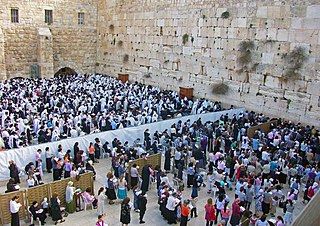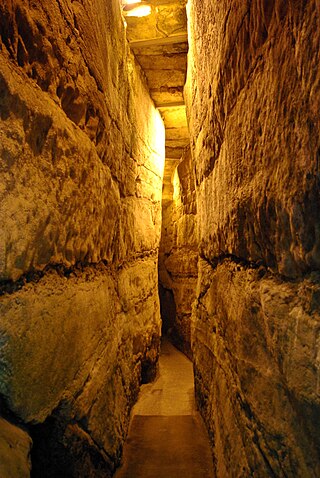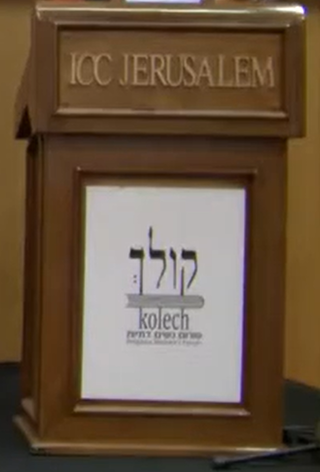
A synagogue, also called a shul or a temple, is a place of worship for Jews and Samaritans. It has a place for prayer where Jews attend religious services or special ceremonies such as weddings, bar and bat mitzvahs, choir performances, and children's plays. They also have rooms for study, social halls, administrative and charitable offices, classrooms for religious and Hebrew studies, and many places to sit and congregate. They often display commemorative, historic, or modern artwork alongside items of Jewish historical significance or history about the synagogue itself.

The Western Wall (Hebrew: הַכּוֹתֶל הַמַּעֲרָבִי, romanized: HaKotel HaMa'aravi, lit. 'the western wall', is an ancient retaining wall of the built-up hill known to Jews and Christians as the Temple Mount of Jerusalem. Its most famous section, known by the same name, often shortened by Jews to the Kotel or Kosel, is known in the West as the Wailing Wall, and in Islam as the Buraq Wall. In a Jewish religious context, the term Western Wall and its variations is used in the narrow sense, for the section used for Jewish prayer; in its broader sense it refers to the entire 488-metre-long retaining wall on the western side of the Temple Mount.

A mechitza in Judaism is a partition, particularly one that is used to separate men and women.

Shlomo Goren, was a Polish-born Israeli rabbi and Talmudic scholar. An Orthodox Jew and Religious Zionist, he was considered a foremost rabbinical legal authority on matters of Jewish religious law (halakha). In 1948, Goren founded and served as the first head of the Military Rabbinate of the Israel Defense Forces (IDF), a position he held until 1968. Subsequently, he served as Chief Rabbi of Tel Aviv–Jaffa between 1968 and his 1972 election as the Chief Rabbi of Israel; the fourth Ashkenazi Jew to hold office. After his 1983 retirement from the country's Chief Rabbinate, Goren served as the head of a yeshiva that he established in Jerusalem.

The Israel Movement for Reform and Progressive Judaism is the organizational branch of Progressive Judaism in Israel, and a member organization of the World Union for Progressive Judaism. It currently has 40 communities and congregations around the state of Israel, 13 of which are new congregations – referred to as U'faratztah communities – and two kibbutzim, Yahel and Lotan.

Women of the Wall is a multi-denominational Jewish feminist organization based in Israel whose goal is to secure the rights of women to pray at the Western Wall, also called the Kotel, in a fashion that includes singing, reading aloud from the Torah and wearing religious garments. Pew Research Center has identified Israel as one of the countries that place "high" restrictions on religion, and there have been limits placed on non-Orthodox streams of Judaism. One of those restrictions is that the Rabbi of the Western Wall has enforced gender segregation and limitations on religious garb worn by women. When the "Women of the Wall" hold monthly prayer services for women on Rosh Hodesh, they observe gender segregation so that Orthodox members may fully participate. But their use of religious garb, singing and reading from a Torah have upset many members of the Orthodox Jewish community, sparking protests and arrests. In May 2013 a judge ruled that a 2003 Israeli Supreme Court ruling prohibiting women from carrying a Torah or wearing prayer shawls had been misinterpreted and that Women of the Wall prayer gatherings at the wall should not be deemed illegal.

The Western Wall Tunnel is a tunnel exposing the Western Wall slightly north from where the traditional, open-air prayer site ends and up to the Wall's northern end. Most of the tunnel is in continuation of the open-air Western Wall and is located under buildings of the Muslim Quarter of the Old City of Jerusalem. While the open-air portion of the Western Wall is approximately 60 metres (200 ft) long, the majority of its original length of 488 metres (1,601 ft) is hidden underground. The tunnel allows access to the remainder of the Wall in a northerly direction.

The Ohel Yitzchak Synagogue, also known as the Shomrei ha-Chomos Synagogue and the Ungarin Shul, is an Orthodox Jewish congregation and synagogue, located in the Muslim Quarter of the Old City of Jerusalem, Israel. It was built as a yeshiva in the 1870s by Kolel Shomrei HaChomos, an organization of Hungarian Jews, but was abandoned after the riots of 1938. Although the building was destroyed after 1948, it was reopened in October 2008 after acquisition by a Religious Zionist group and subsequent refurbishment.
The Tzuf Dvash Synagogue is an Orthodox Jewish congregation and synagogue, located at 15 Plugat ha-Kotel Street in the Jewish Quarter of the Old City of Jerusalem. The congregation was founded in 1860 under Ottoman Empire rule and worships in the Sephardic rite.

The Little Western Wall, also known as HaKotel HaKatan or just Kotel Katan, Kleiner Koisel, the Small, or Little Kotel, is a Jewish religious site located in the Muslim Quarter of the Old City of Jerusalem near the Iron Gate to the Temple Mount. The wall itself dates from the Second Temple period. It is part of the Western Wall, a retaining wall of the Herodian Temple compound which also contains the by far more famous and larger section known in the West as the Wailing Wall, and almost exactly faces the Holy of Holies. HaKotel HaKatan and its famous counterpart are the only sections of the almost 500 m long Western Wall not covered by houses, but the smaller free-standing section is not as crowded as the larger one. This section of the wall is of deep spiritual significance because of its close proximity to the Holy of Holies. However, it is not the closest location to the Holy of Holies, as there is a location in the Western Wall Tunnel which directly faces the Holy of Holies.

Shmuel Rabinovitch, also spelled Rabinowitz is an Orthodox rabbi and Rabbi of the Western Wall and the Holy Sites of Israel. In his duties as Rabbi of the Wall in the Old City of Jerusalem, Rabbi Rabinovich maintains the historic traditional Jewish practices of the Wall as a site of orthodox Jewish prayer and ensures that notes placed in the Wall are removed and treated consistent with tradition and halakhah. He escorts visiting heads of state and foreign dignitaries during visits to the Wall, and has published on the Jewish laws and customs of the Western Wall.
In Judaism, especially in Orthodox Judaism, there are a number of settings in which men and women are kept separate in order to conform with various elements of halakha and to prevent men and women from mingling. Other streams of Judaism rarely separate genders any more than secular western society.

Aryeh Stern is the Ashkenazi Chief Rabbi of Jerusalem, a member of the Chief Rabbinate Council of Israel, and the chief editor of the Halacha Brura and Berur Halacha Institute.

Wilson's Arch is the modern name for an ancient stone arch in Jerusalem, the first in a row of arches that supported a large bridge connecting the Herodian Temple Mount with the Upper City on the opposite Western Hill. The Arch springs from the Western Wall and is still visible underneath later buildings set against the Wall. The name Wilson's Arch is also used to denote the hall that it partially covers, which is currently used as a synagogue. This hall opens towards the Western Wall Plaza at the Plaza's northeast corner, so that it appears on the left of the prayer section of the Western Wall to visitors facing the Wall.

Ohel David Synagogue, also called Laal Deval or Laal Deul is a synagogue in Pune, India.
Women for the Wall, sometimes abbreviated as W4W, is a grassroots Jewish women's traditionalist organization founded in April 2013, formed in opposition to the Women of the Wall (WoW), a Jewish women's group promoting egalitarian prayer at the Western Wall, the Jewish holy site in Jerusalem.

Anat Hoffman is an Israeli activist and the former executive director of the Israel Religious Action Center, also known as IRAC. She is the director and founding member of Nashot HaKotel, also known as Women of the Wall. Hoffman is a former member of the Jerusalem City Council. In 2013, the Israeli newspaper Haaretz named her "Person of the Year", noting the award reflected "the prominence that she has achieved across the Jewish world over the past 12 months". The Jerusalem Post listed her fifth, among its list of 50 Most Influential Jews, for forcefully and successfully bringing the issue of women's rights at the Kotel to the "forefront of the consciousness of world Jewry".

The Kotel compromise is a compromise reached between orthodox and non-orthodox Jewish denominations, according to which the non-Orthodox "mixed" prayer area for men and women was supposed to be expanded in the southern part of the Western Wall. In contrast to the existing situation, access to this "mixed" prayer area was supposed to be from the main entrance to the Western Wall, and in addition it was supposed to be run by a council which would contain representatives of the non-Orthodox denominations and women of the Wall.

Lesley Sachs is an Israeli social activist and leader of battles for gender equality and religious freedom, CEO and Artist. She served as the CEO of The Israel Women's Network (IWN), the Israel Religious Action Center (IRAC), the World Union for Progressive Judaism (WUPJ) and Women of the Wall (WOW).

Kolech, also known as Kolech: Religious Women's Forum, is an Israeli women's organization associated with Orthodox Judaism. The group's stance is aligned with Orthodox Jewish feminism and religious Zionism.
















